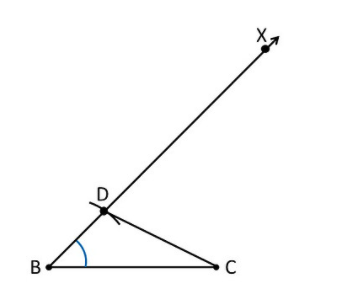To construct a triangle given its base, a base angle and the difference of the other two sides.
Draw a base BC
Draw ∠B. Let the ray be BX

Open the compass to length AB−AC. From point B as center, cut an arc on ray BX. Let the arc intersect BX Let the arc intersect BX at D. Join CD.

We will draw perpendicular bisector intersects BD. Join AC.

△ABC is the required triangle.
Topper's Solved these Questions
- BOOK - NCERT ENGLISHCHAPTER - CONSTRUCTIONSEXERCISE - Example1videos
CONSTRUCTIONS
- BOOK - NCERT ENGLISHCHAPTER - CONSTRUCTIONSEXERCISE - EXERCISE 11.15videos
CONSTRUCTIONS
- BOOK - NCERT ENGLISHCHAPTER - CIRCLESEXERCISE - Exercise 10.33videos
CIRCLES
- BOOK - NCERT ENGLISHCHAPTER - COORDINATE GEOMETRYEXERCISE - Solved Examples4videos
COORDINATE GEOMETRY
Similar Questions
To construct a triangle, given its base, a base angle and sum of other two sides.
View SolutionTo construct a triangle, given its perimeter and its two base angles.
View SolutionThe hypotenuse of a right triangle is 13 cm and the difference between the other two sides is 7cm. Find the two unknown side of the triangle.
View SolutionProve that in a triangle, if the square of one side is equal to the sum of the squares of the other two sides, then the angles opposite to the first side is a right angle.
View SolutionProve that in a triangle if the square of one side is equal to the sum of the squares of the other two side then the angle opposite to the first side is a right angle.
View SolutionThe altitude of a right triangle is 7 cm less than its base. If the hypotenuse is 13 cm, find the other two sides.
View SolutionConstruct an equilateral triangle, given its side and justify the construction.
View SolutionProve that the angle between internal bisector of one base angle and the external bisector of the other base angle of a triangle is equal to one-half of the vertical angle.
View SolutionProve that the angle between internal bisector of one base angle and the external bisector of the other base angle of a triangle is equal to one half of the vertical angle.
View SolutionIf the square of one side of a triangle is equal to the sum of the squares of the other two sides then the triangle is a right triangle with the angle opposite the first sides as right angle.
View Solution

